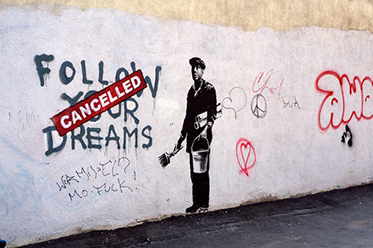 Over the last six months, I have been thinking, writing and talking about the artist’s role, value and agency in society. I’ve been speaking to the idea that an artist’s contribution to society is, in part, their capacity for adhesion – that is, to stick seemingly unrelated elements together and provide meaning for the whole of society, including the economy within.
Over the last six months, I have been thinking, writing and talking about the artist’s role, value and agency in society. I’ve been speaking to the idea that an artist’s contribution to society is, in part, their capacity for adhesion – that is, to stick seemingly unrelated elements together and provide meaning for the whole of society, including the economy within.
Inherent in this is the tension between the artist as citizen and the artist as worker.
The workers in the arts industry
Australian artists are the labour on which the so-called “arts industry” is based. The creative economy driven by artists and their labour is – depending which report you read – one of the fastest growing sectors in Australia. And with manufacturing and mining sectors in decline, the currency of Australia’s new economy will be ideas. The intellectual and creative capital generated by the arts remains desirable.
A high functioning market depends upon properly functioning industry.
The problem with the arts industry is the perilous position of its primary producers, the artists. Artists are the lowest paid members of the arts industry (and the Australian workforce). On average, they earn A$7,000 a year from their practice. According to Peter Shergold in his 2011 discussion paper on arts funding, direct funding for individual artists in Australia has fallen by a third since the 1990s.
What kind of an industry has the majority of its primary producers living below the poverty line?
Perversely, if artists were to withdraw their labour the whole damned thing would collapse. So there is an inverse aspect to this parasitic relationship – between the value of the artist to the industry and the value the industry assigns the artist.
Autonomy for artists?
On other indicators such as influence and agency, artists are also at the bottom of the food chain.
Their autonomy has been curtailed by policy that institutionalises them within organisations, events and venues that curate culture on behalf of funding agencies. They have little or no influence in determining their conditions, as they are barely visible at elite levels of governance.
And most troubling, their diminished condition has been facilitated within and by the arts industry whose growth is predicated on maintaining their inequitable position in the equation of artistic production.
It’s important background to the activation of Australian artists over the last few months: the Sydney Biennale boycott, the issue of payment to independent artists by the Melbourne Theatre Company and the supposed self-censorship of a politically-sensitive line from an Australian play by the Artistic Director of the Queensland Theatre Company.
The kicker of course is the current arts minister’s seemingly threatening overtures regarding sponsorship policy. One reason Australian artists are activating now is because they feel they have nothing to lose. It’s often when one feels most disempowered that one appreciates one’s actual power.
Artists strike – today
On the basis of these industrial conditions, last year I called for a national artists strike which I’ve been asked to revisit for this piece in terms of how it might look today.
Let’s imagine a scenario whereby all artists – including actors, dancers, musicians, choreographers, composers, designers, directors, sculptors, photographers, writers, media artists, digital artists, painters and sound artists – undertake a month-long retraction of their labour.
There would be widespread disruption or cancellation of theatre, dance, music, opera as well as visual arts exhibitions in which the work of living artists is presented and all the education programs that take place within these spaces and within schools – a total shutdown of the presentation of the performing, visual and media arts.
The major organisations, cultural institutions and events would close their doors and retrench their staff.
No festivals, no blockbusters, no shows. The greater economy would suffer significantly because of the knock-on effect to related industries such as transport, childcare, hospitality, and so on.
Social wellbeing indices would dive as an active arts sector mitigates social health problems.
What the arts holds together would come unstuck. This is where the industrial concerns of the artist impact on civic society.
Conversely, when those Biennale artists boycotted the event their point of departure was civic action: active citizens withdrawing their labour on ethical grounds. This conflation of the artist as worker and citizen has come about because of a shift in artists’ understanding of the value of their work.
It starts with a resistance to the singular compression of their work to a monetary value – it has that, of course, and that is what feeds their families. But it does not constitute its only value and meaning.
Value and meaning are also found in the industrial context in which artists make and present their work and artists’ complicity in the governing social and political contexts. These concentric circles of action and connection, of labour and values, are central to the identity of artists as citizens and workers.
As more Australian artists discover how to keep these balls in the air, the question is: where will they next draw the line?
David Pledger does not work for, consult to, own shares in or receive funding from any company or organisation that would benefit from this article, and has no relevant affiliations.
This article was originally published on The Conversation.
Read the original article.
